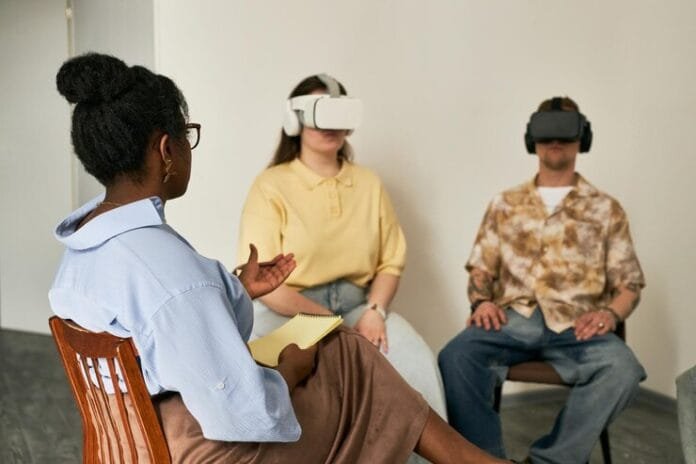The fluorescent hum of the waiting room buzzed like a familiar soundtrack to the quiet anxieties inside its walls. I’d been at this for years, a lifetime it seemed, in the lonely choreography of one-on-one therapy, the intimate, sometimes alienating bounce of my own narrative reverberating back from a single, attentive face. But a sea change was taking place, a quiet revolution taking shape beyond those fortified offices. I witnessed it in the tired faces of colleagues strained by unmanageable caseloads; in muted conversations about innovative models of care; and in the increasing demands of people who want, above all, connection, not just a diagnosis. It was a real hunger for something better.
That craving, I discovered, was not only mine. It was a shared longing for a new way — another step to healing that didn’t take place in clinical rooms with exorbitant hourly rates. And then I saw it: a gathering of people, not in solitude but in collective fragility. Laughter, tears, like stories woven together in the fibers of a huge tapestry, and a feeling of “I’m not alone in this.” The air was charged with a different sort of electricity, an almost tangible call to hope growing like flowers in the rich soil of shared experience. It was not only therapy; it was a microcosm of human connection, a living, breathing example of the collective carries us.
Now, we are at a turning point. The traditional paradigm of mental healthcare, though still fundamental, is fundamentally at odds with the breaking pressures of a planet in lockstep with unprecedented stress and isolation. For the future of healing, will we find it not in the individual silos, but in the unifying power of the group? How can we harness this deep human instinct to not only ease suffering, but create a kinder, tougher community? Could it be possible that group therapy is not just an alternative, but the blueprint to a new era of revolutionary mental health care?
Let’s wade into the swirling eddies of the group therapy market — a corner where the vulnerable meet the more together, and healing springs from shared experience. It’s not your mother’s comfortable couches and empathetic nods any more; this space is being reshaped by powerful forces, some promising, some a sharp challenge.

Positive Trends – The Tide is Rising
- The first one is the rise of Technological Integration. Forget dusty flip charts; virtual platforms are now the lifeblood of group sessions, the main arteries. Imagine something more like ‘BetterHelp’ but in a group setting — nearly bridging physical boundaries to connect people. That means access widens, costs often narrow, and scheduling is a breeze. Moreover, tools powered by AI are beginning to tailor group content, aligning needs, and encouraging more meaningful interaction. It’s not so much about conforming everyone into a strict mold, it’s more about creating spaces that mould to the people.
- The second is an undeniable Destigmatization of Mental Health. Shadows of shame are fading and open conversations are taking hold. More people now feel comfortable reaching out for help, which contributes to the uptick in demand for group therapy. Consider the surge of mental health advocates on social media; they’re not just telling their stories, they’re starting a movement, tearing down invisible walls that once left a whole lot of us locked up inside.
- Last but not least, the emergence of Specialized Groups. No more generic groups; now we have laser-focused sessions. Support groups specifically designed for LGBTQIA+ individuals, chronic pain warriors or grieving folks. This jesture of being needed encourages deeper connections, and they find a community where they belong, a home where their experiences need no explanation.
Adverse Trends – The Choppy Waters
- But the journey isn’t without its rough waters. Issue of the Rise of Unregulated Virtual Platforms As demand for remote therapy has surged, well-intentioned but ultimately unqualified providers and less-than-secure platforms can put clients at risk. It’s like walking on stage without knowing the play, and the possibility of misdirection and harm is real.”
- And we cannot overlook the Cost Sensitivity. With inflation pinching, price-conscious clients probably will be tempted to skip professional advice, or replace it with cheaper, less-advisable options. A cruel irony, of sorts — that when people need mental support more than ever, financial pressures could render it even more out of reach.
Actionable Insights – Charting a Course
So how do strategists maneuver this landscape? Embrace the positive trends:
- Invest in Secure, Strong Technology: Create comprehensive virtual platforms that are user-friendly, focused on privacy and client security. Go beyond a Zoom call and craft an immersive, exciting experience.
- Amplifiy The Talk: Collaborate with mental health advocates and leverage social media to educate and destigmatize group therapy. Don’t be silent, be a part of the chorus.
- Specialize & Unique: Find what are the gaps in group therapy and create customized programs to meet those gaps. Would-be home chef, be a craftsman, not a mass producer.
- Mitigate the adverse trends:
- Standardize and Certify: Promote stricter regulations and certification for online therapy platforms. Be a watchman, not a bystander.
- Nurture Alternative Financial Models: These may include flexible payments, sliding scales, or working with insurance форм providers to open access to those in need. If you are a leader, seasoned professional or junior team leader, there’s implication here: Be an innovator, not a roadblock.
The market for group therapy is a complex and nuanced landscape that is both hopeful and challenging. By successfully riding these waves, companies can help cultivate a world in which mental health is a shared goal, and not just achievable for the few. It’s not just about profit, it’s about the visceral vibration of collective healing, one cohort at a time.
At a busy health facility, nurses exhausted from the unending toll of the pandemic meet weekly to discuss their problems in a group therapy session. The air in the room that is thick with unarticulated fears slowly thins when they start sharing. Sarah recalls one especially harrowing night shift, her voice shaking, her hands flailing as she recalls the weight of each lost life. Mark, normally stoic, confesses to being increasingly disconnected from his work, his gaze lowered, his spirit morose. They learn to acknowledge shared patterns of being worn down and craft strategies within themselves to deal with emotional exhaustion — through choreographed conversations. The laughter, sometimes bittersweet, fills the room as they commiserate over their shared hard knock life. Throughout the film, that feeling of isolation seeped away into a resilient sense of comradery that refreshes their caregiving.
In an innovative tech company, the pervasive push to innovate causes strained relationships among project teams. A bunch of introverted software engineers participate in a group facilitated therapy session. At first, they speak with wary skepticism, their eyes glued to their twitching hands. As they tentatively explore each other’s perspectives, though, they reveal a mutual fear of failure that suppresses creativity. David, a normally soft-spoken coder, opens up over the shame of feeling sidelined after a failed project, raw emotion in his voice. The group’s sympathetic nods help him articulate his ideas a little more freely, in turn building up a shared, collaborative sort of momentum. By the end of the therapy session, a previously disjointed team bonds and learns to leverage each other’s strengths, rising together to the occasion as setbacks arise.
In the high-stakes world of car manufacture, an atmosphere of high-pressure yields a tense and disengaged workforce. A support group for assembly line workers to work out their issues. Calloused hands holding the edge of the chair press down as they recount moments of mutual distrust and simmering resentments. “Maria” — a fictional representation of one of many real-world DAs — recalls a near-contest itself due to bad communication — her voice laden with frustration. His eyes ablaze, Javier acknowledges feeling overlooked and underappreciated. They break down the underlying dynamics of their dysfunctional relationships through facilitated dialogues. They find that their tensions often arose from the stress of the production line and not from malevolence. This results in a renewed sense of workplace etiquette, it’s like Henry Ford and Harvey Firestone took one huge tree and carved out each heart, junks, twist and frown and soon workers are advocates for one another, curtains are more fun, rude remarks embellished with dough!
Start: Broader Audience and Deeper Products
We witnessed a fierce effort by platforms to grow their audience. Consider “MindBloom” as an example. Rather than implementing only standard group sessions, they began adding: more specialized groups (grief support circles, new parent sessions, etc.). “We had to be more than a one-solution provider,” CEO Amelia told staff in an internal meeting. “Our users have many different needs.” It was an organic strategy that that relied on deep dives into user feedback and market research to find these underserved niches. They’ve also poured a lot of money into marketing campaigns focused on these new, specialized groups — trying to reach people who may have been put off by traditional group therapy formats.
Middle Stage: Strategic Partnerships and Tech Integration
And so many companies, recognising that with help, growth can be quicker, began forming inorganic alliances. A startup named “TogetherWeHeal” teamed up with several Employee Assistance Programs (EAPs). It provided them immediate access to a sizable, existing universe of employees looking for mental health care. “It’s about leveraging existing ecosystems,” said David, the company’s lead strategist, “we could reach thousands without having to create it from the ground up”. In addition to partnerships, there was a heavy focus on tech integration. For instance, “ConnectWell” introduced AI-powered matching algorithms to connect individuals with therapeutic resources and groups that might be better matched to their needs and preferences. The takeaway: Tech infusion was also critical in boosting user experience and satisfaction, with the oft-cited reason for continuing to use the platform being ‘better fits.’
Conclusion: Diversifying Revenue Streams and Future-Proofing
Diversification became key as the market matured. “ClarityMind” started offering subscription tiers, with more premium offerings being access to certified peer support specialists and individual check-ins on top of the group therapy. They evolved from a pure model of group therapy, offering more hybrid solutions. This was not just about new streams of revenue, but sustainability and flexibility for the long-term. We saw a forward-looking focus too, looking towards integration and future use cases, the metaverse, and developing VR therapy options (albeit at an early stage) — all indicative of a long term commitment to future-proofing the platform. “The digital space is constantly evolving,” said Sarah, their technology officer, “and we want to be on the cutting end and provide cutting edge solutions”.

Outlook & Summary: A Symphony of Shared Healing
Envision a place where the individual therapy room’s sterile silence is becoming filled with vibrant chaos of shared experience. From niche option to a cornerstone of mental healthcare: In the next 5 to 10 years we are on track to see group therapy go from being a niche option to a cornerstone of mental healthcare. Out with the silent, sterilized spaces of clinical rooms; in with the buzz of community in therapeutic circles. Imagine a tapestry stitched with threads of vulnerability, empathy, and collective strength – that is the terrain we are moving into.
This is not just a fad; it’s a tectonic shift. With skyrocketing demand for mental health services, individual therapy cannot shoulder the load. The role of group therapy, with its inherent operating efficiency and the power potential unleashed, is a radical solution. It’s not about superseding one with the other; it’s about achieving a balanced ecosystem. We’re imagining a scenario where people are more than just patients — they are co-creators in an ongoing narrative of health propelled forward by the shared narratives of their peers. The sense of not being alone might be the balm a lot of people want.
And having led you along this path here, dear reader, we hope we have inspired in you a deeper appreciation of this evolution, from potential to address accessibility issues, to the primal human connection it creates with everyone involved. However, with this transition comes perhaps the most important question of all for myself and for all who nurture the future of the mental space: Are we ready to embrace and foster collective healing to be a part of the larger music of mental care?

